Meet Senator David Wells
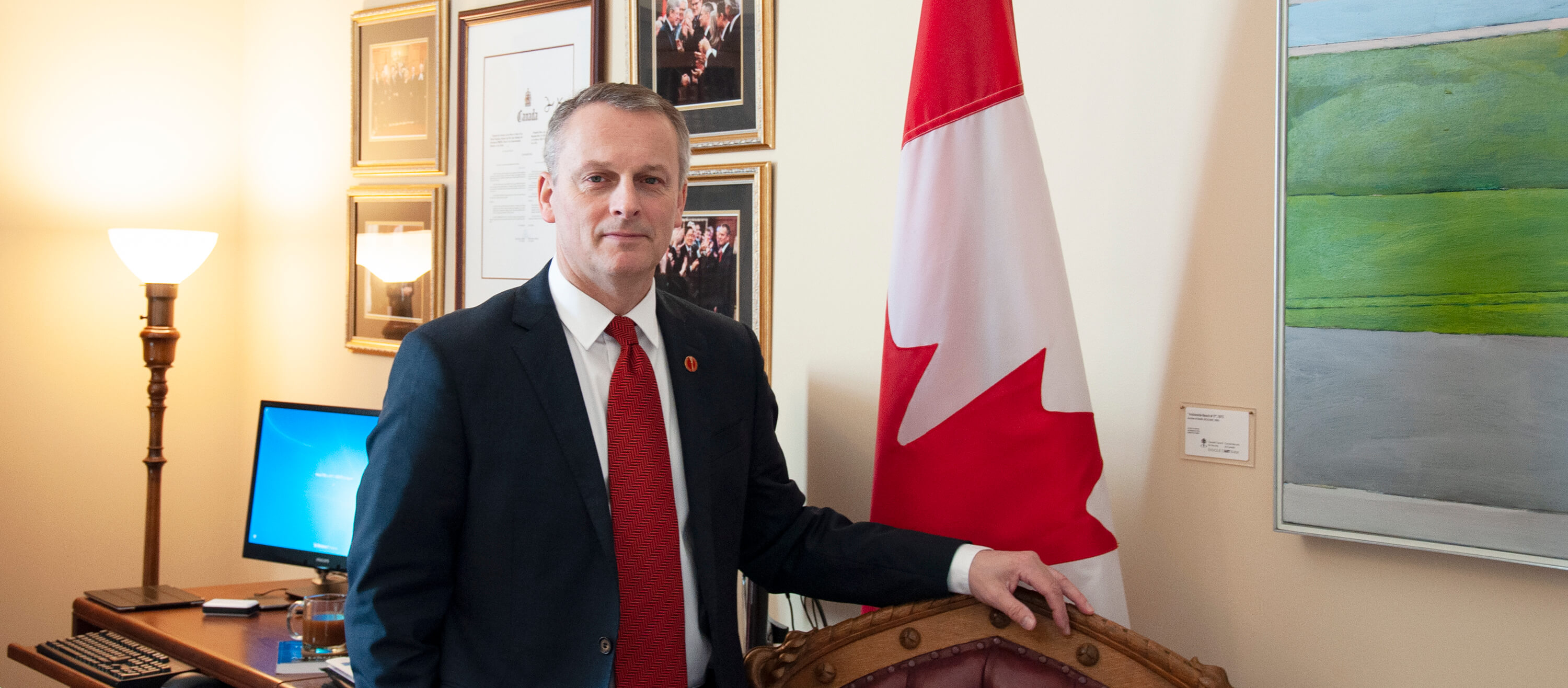
Senator David Wells lives at sea level along the rugged shores of Newfoundland and Labrador, but he often seeks higher ground climbing some of the world’s tallest peaks as a high-altitude mountaineer. He has summitted mountains in the Andes, the Himalaya and the Russian Caucasus. When he’s not in the clouds, he promotes what he calls “responsible resource development” in the Senate, drawing on his experience as Deputy CEO of the Canada-Newfoundland and Labrador Offshore Petroleum Board.
Senator Wells was appointed to the Senate on January 25, 2013.
Who inspired you to get involved in public life?
There wasn’t a particular person who inspired me, but I’ve always been involved in my community. I spent a lot of time volunteering with Big Brothers Big Sisters Canada, I was on the school council for my kids’ elementary school and I coached my son’s minor hockey team. Being a senator is just an extension of that desire for community service, but on a national scale.
I was a mentor with Big Brothers Big Sisters for a young fellow whose father was not on the scene anymore; I did that in my 20s. It was as rewarding for me as much as it was rewarding and valuable for the boy. It was before I had kids of my own. It’s hard to put into words but it’s a feeling of accomplishment that you have that you’re contributing to your community and to society in a tangible way, whether you’re going to the movies with him or you’re playing a sport in the park. I didn’t think I’d be carrying this experience for the rest of my life but here I am still talking about it in my 50s.
What is one thing most Canadians might not know about you?
Some people probably know I’m a high-altitude mountaineer, but they likely don’t know what happened to me when I was climbing the Aconcagua in Argentina. It’s the highest peak in the Western Hemisphere at almost 7,000 metres. I did that with an international team of climbers, led by two Argentinian guides. However, our two guides got sick in the middle of the climb up this enormous mountain and went back down — but I kept on going!
The guides both had altitude sickness — one was coughing up blood and the other had severe headaches. It’s the number one reason high-altitude climbers turn back. Four of the climbers also returned to high camp and there were three of us left. I was the most experienced, so I led the group to the summit. It was just me, a climber from Germany and another from Poland. We pushed through that last 300 metres, which took about seven hours. It was a rock and ice climb without any guides at the bitterest cold temperatures and the highest winds you could imagine. It was probably -30 C. Nothing is guaranteed in the life of a climber and that’s part of the risk. Everything conspires against you, whether it’s the weather, the stability of whatever’s underfoot, your gear or your body.
So, you’re in bone-chilling temperatures, there’s rock and ice everywhere and your only two guides turn around and go back down. Why did you keep going? Most people would call you crazy.
Maybe they’re right, but I was feeling healthy, my gear was working. I had water, I had protein bars. I was feeling great. You’re motivated by something within. You always have second thoughts, but the ones that tell you to keep going forward are stronger. I did slip at one point on some loose rock and fell on my left elbow and chipped some bones. I never had them removed so every day I feel those chipped bones in my elbow. It’s a stark reminder of that climb and of the dangers of it.
I couldn’t wait to get off the mountain but for whatever reason it was a good day for me, and I felt strong. I was motivated to get to the top. I have enough sense to turn around when I know I’m in greater danger than I was on that day, but I felt confident. All the right elements were working for me. In the end, the three of us reached the top after 17 days.
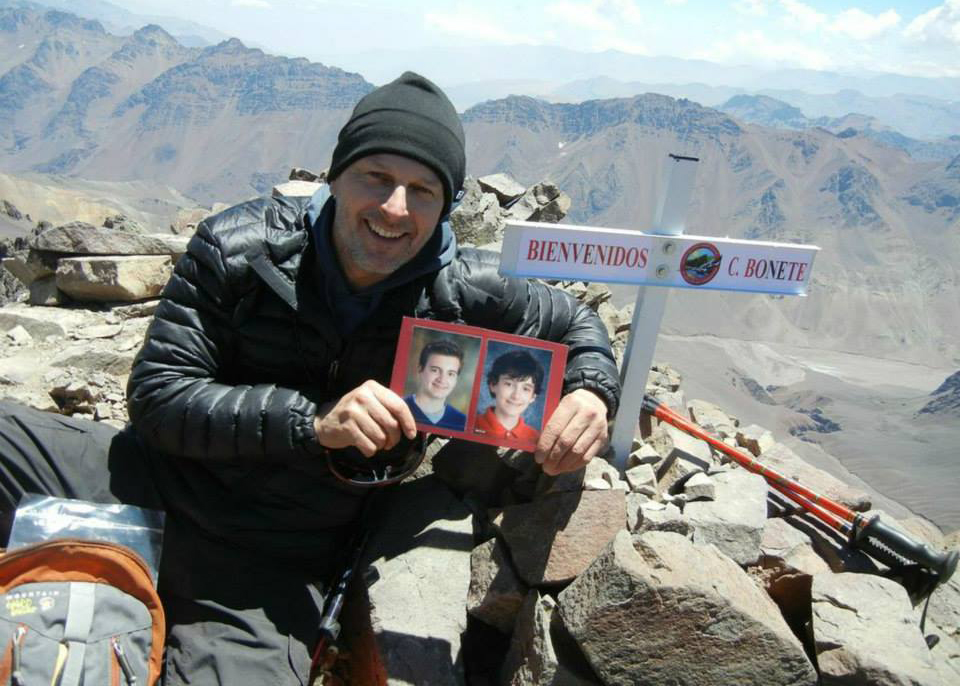
Senator David Wells on a 5,000-metre training climb of Mount Bonete in the Andes in 2014 in preparation for Aconcagua. He always takes photos of his sons, Luke and Alex, on his climbs.
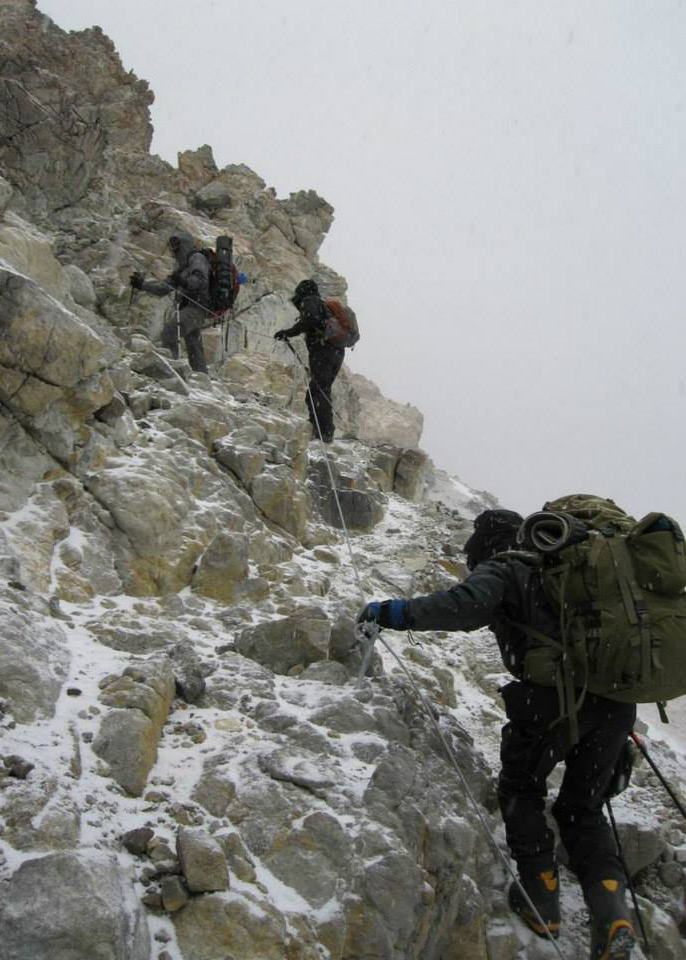
Senator Wells had to use fixed rope on a section of rock and ice on Aconcagua in 2014, which is 6,960 metres above sea level in the Argentinian Andes. “This is the most dangerous part of the climb,” the senator said.
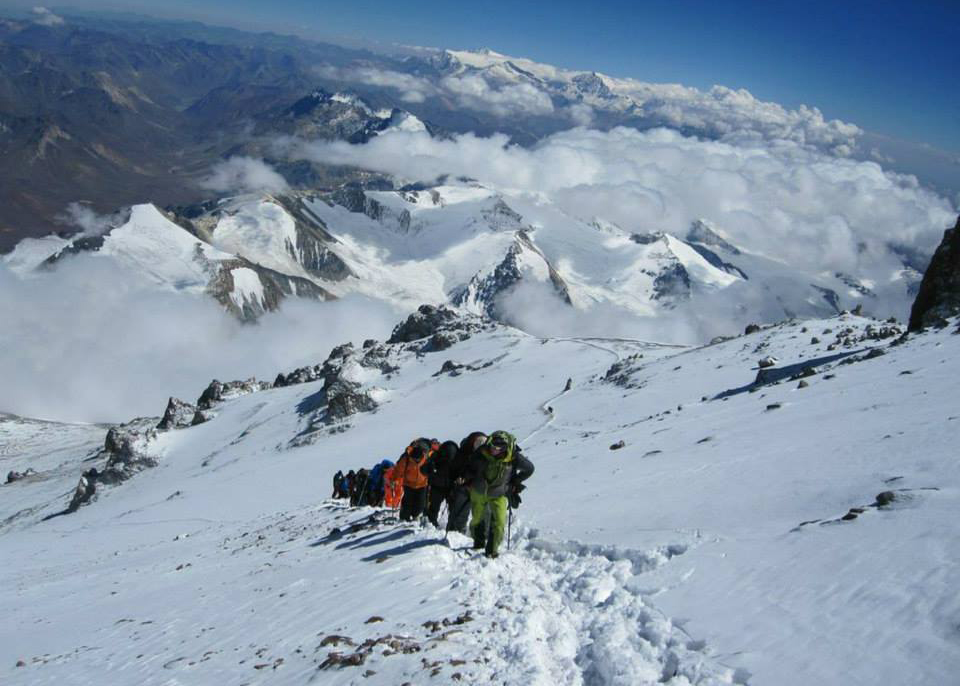
Senator Wells summited Aconcagua in 2014 with a group of international climbers. “This is the point where most people turn back,” he said. “Only 30% of those who attempt Aconcagua make it to the top.”
Turning to your role in the Senate, you’ve done a number of youth outreach events with the SENgage program, including the recent first-ever Model Senate. Why is engaging with youth important to you?
It keeps me grounded. All day, I’m working with senators, cabinet ministers or other MPs, diplomats — but when you see kids you see their enthusiasm. When I explain my role, I enjoy it because I know they’re learning. That’s part of it. And just like Big Brothers Big Sisters, I get as much out of it as they do.

Senator Wells gives a presentation to model Senate participants during the first-ever Model Senate in January 2020, which saw students debating legislation, learning parliamentary procedures and investigating issues.
I think there’s a general lack of civic literacy — the Senate provides an important check on executive power. It’s good to remind people of that. Look at countries that don’t have that check, they’re dictatorships or one-party states. In Canada, the Senate provides that challenge function, just like the Official Opposition provides a challenge function. Unless you have a public, organized challenge function on the power of the executive, you have less accountability, less transparency and less of all the things that make Canada great.
What legislative or committee work are you most proud to have participated in?
Bill C-48, the Oil Tanker Moratorium Act, was instituted when there was no tanker traffic along northern B.C. It was essentially a backdoor ban to further starve the export market of one of Canada’s greatest natural resources, petroleum. That disadvantaged Alberta. Here in Newfoundland and Labrador, we have Placentia Bay on the southern part of the province — there are hundreds of tankers that go in and out of that bay every year. There are ferries, fishing processing operations, aquaculture facilities and a nickel processing facility. And it’s one of the foggiest places in the world. So, if thousands of vessels can operate safely and effectively in an environment like that, why can’t it be done in British Columbia? Is B.C.’s coastline more pristine or more fragile than Newfoundland and Labrador’s? I don’t think so. I spoke about this vociferously when we debated C-48 in the Chamber and used that example of Placentia Bay.
In my work in the Canada-Newfoundland and Labrador Offshore Petroleum Board I could see very clearly how regulations could be put in place to ensure maximum safety. Canada was built on natural resources. In my public life and in the Senate, I’m an active promoter of responsible resource development. The petroleum board was in charge of resource management, health and safety, environmental issues and industrial benefits. The understanding of how regulations work to drive business has helped me a lot since becoming a senator because I have a very good understanding of regulations that are empowered by legislation.
Is there a hidden gem in your region that more Canadians need to know about?
If you fly into St. John’s, within a 10-minute drive you can see the most rugged coastline with high seas, waves, picturesque beauty and just terrific hiking trails. On the east coast of Newfoundland and Labrador, we have a trail system called the East Coast Trail. Hikers from around the world come here to experience it. You’re hiking mere metres from the jagged coastline with sandy and rocky beaches. You can pretty much pitch a tent wherever you like. It’s a hidden gem because people who come to St. John’s stay in the city, but in just a few minutes’ drive you can find one of the most unspoiled vistas and look out to the Atlantic. There are whales, seabirds, icebergs and friendly people. I also live about 200 metres from the water, so I’m close to the trail.
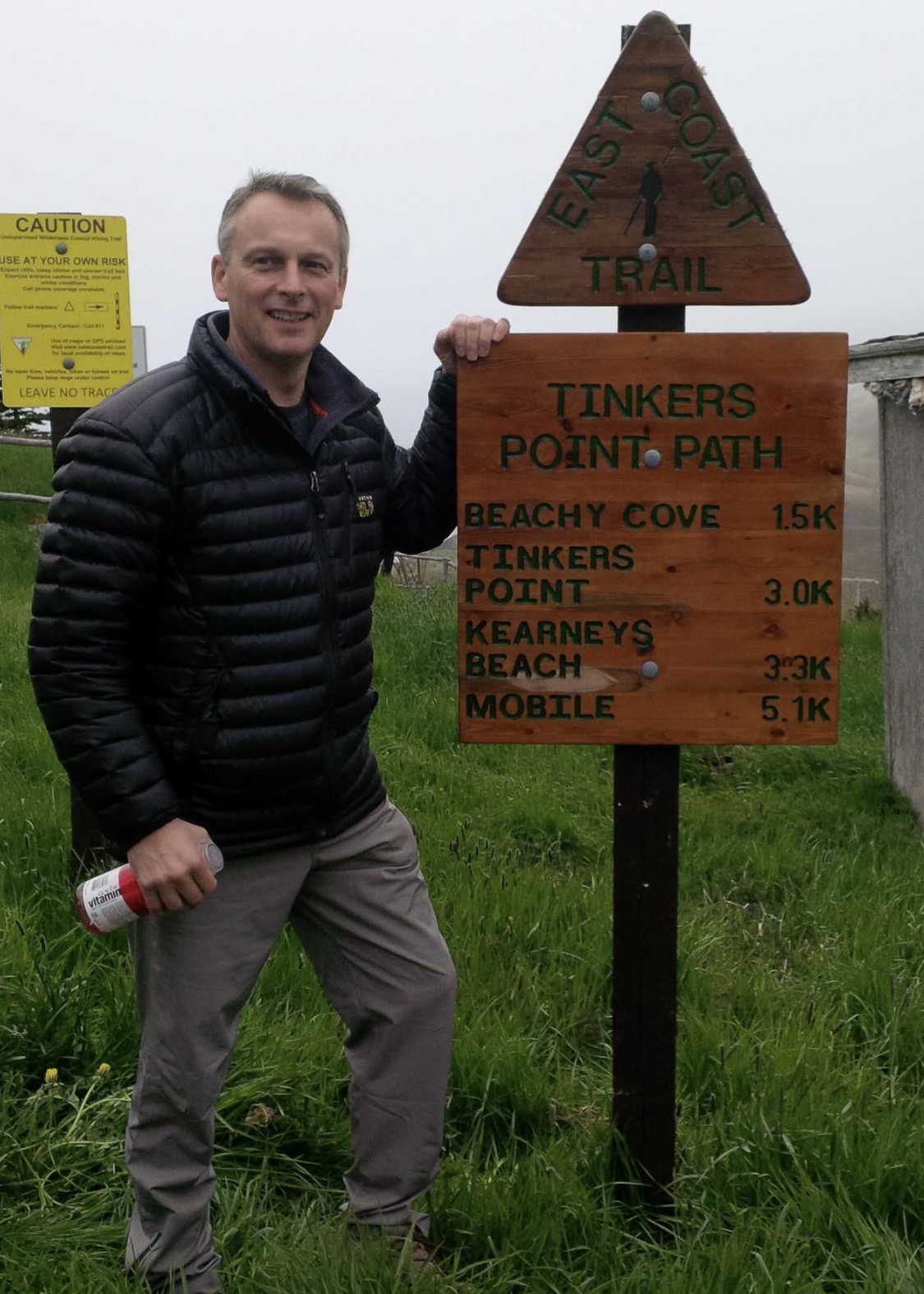
Senator Wells often visits the East Coast Trail in Newfoundland and Labrador since it’s close to home.
Can you name a guilty pleasure song / album that always makes you smile and why?
There’s a legendary blues artist from St. John’s named Roger Howse. He’s an old, traditional blues player, a great songwriter and a great singer. I know Roger. In fact, I awarded him a Senate sesquicentennial medal last year for what he has done for the arts and music industries, not just in Newfoundland and Labrador, but across Canada. He’s also an advocate for mental health. I’ve been listening to him since the 70s but my favourite song is called “The Drifter” from his band, Ruff Ideas. It’s a terrific tune and Roger is a regular in my playlists.
What is the last book you recommended to someone and why did you recommend it?
The last book I read was given to me by my wife, Ann, called The Newfoundland Journal of Aaron Thomas, 1794. This guy came across the Atlantic from England on a boat in 1794, stayed until 1795 and it’s just a chronicle of things that he did when he was here, the villages that he went to, the people he met and about walking through St. John’s. And now, I’m walking the same streets as this gentleman did in the 1700s, though they look a little different now. I recently recommended the book to someone in a Facebook group about old St. John’s.
What sports team do you support?
I used to play rugby at the provincial level and played in the Canada Summer Games back in 1981 in Thunder Bay. I played for a team in Newfoundland called the Swilers. That team is still in existence and it was one of the founding teams in the province. I’m a social member of the rugby club but I don’t play anymore. It’s been a fixture in the community, and I’ve been an active supporter of the team for about 40 years.
Why are you proud to be Canadian?
By any measure, Canada is the greatest country in the world. We have freedoms, we have responsibilities, it’s a place where people want to live. If you live elsewhere, Canada is seen as a beacon. We still have to work to maintain that, though. We’re a great country for many reasons, but we should never take it for granted. We always have to work to maintain what makes Canada great.
Related articles
Tags
Committee news
Meet Senator David Wells

Senator David Wells lives at sea level along the rugged shores of Newfoundland and Labrador, but he often seeks higher ground climbing some of the world’s tallest peaks as a high-altitude mountaineer. He has summitted mountains in the Andes, the Himalaya and the Russian Caucasus. When he’s not in the clouds, he promotes what he calls “responsible resource development” in the Senate, drawing on his experience as Deputy CEO of the Canada-Newfoundland and Labrador Offshore Petroleum Board.
Senator Wells was appointed to the Senate on January 25, 2013.
Who inspired you to get involved in public life?
There wasn’t a particular person who inspired me, but I’ve always been involved in my community. I spent a lot of time volunteering with Big Brothers Big Sisters Canada, I was on the school council for my kids’ elementary school and I coached my son’s minor hockey team. Being a senator is just an extension of that desire for community service, but on a national scale.
I was a mentor with Big Brothers Big Sisters for a young fellow whose father was not on the scene anymore; I did that in my 20s. It was as rewarding for me as much as it was rewarding and valuable for the boy. It was before I had kids of my own. It’s hard to put into words but it’s a feeling of accomplishment that you have that you’re contributing to your community and to society in a tangible way, whether you’re going to the movies with him or you’re playing a sport in the park. I didn’t think I’d be carrying this experience for the rest of my life but here I am still talking about it in my 50s.
What is one thing most Canadians might not know about you?
Some people probably know I’m a high-altitude mountaineer, but they likely don’t know what happened to me when I was climbing the Aconcagua in Argentina. It’s the highest peak in the Western Hemisphere at almost 7,000 metres. I did that with an international team of climbers, led by two Argentinian guides. However, our two guides got sick in the middle of the climb up this enormous mountain and went back down — but I kept on going!
The guides both had altitude sickness — one was coughing up blood and the other had severe headaches. It’s the number one reason high-altitude climbers turn back. Four of the climbers also returned to high camp and there were three of us left. I was the most experienced, so I led the group to the summit. It was just me, a climber from Germany and another from Poland. We pushed through that last 300 metres, which took about seven hours. It was a rock and ice climb without any guides at the bitterest cold temperatures and the highest winds you could imagine. It was probably -30 C. Nothing is guaranteed in the life of a climber and that’s part of the risk. Everything conspires against you, whether it’s the weather, the stability of whatever’s underfoot, your gear or your body.
So, you’re in bone-chilling temperatures, there’s rock and ice everywhere and your only two guides turn around and go back down. Why did you keep going? Most people would call you crazy.
Maybe they’re right, but I was feeling healthy, my gear was working. I had water, I had protein bars. I was feeling great. You’re motivated by something within. You always have second thoughts, but the ones that tell you to keep going forward are stronger. I did slip at one point on some loose rock and fell on my left elbow and chipped some bones. I never had them removed so every day I feel those chipped bones in my elbow. It’s a stark reminder of that climb and of the dangers of it.
I couldn’t wait to get off the mountain but for whatever reason it was a good day for me, and I felt strong. I was motivated to get to the top. I have enough sense to turn around when I know I’m in greater danger than I was on that day, but I felt confident. All the right elements were working for me. In the end, the three of us reached the top after 17 days.

Senator David Wells on a 5,000-metre training climb of Mount Bonete in the Andes in 2014 in preparation for Aconcagua. He always takes photos of his sons, Luke and Alex, on his climbs.

Senator Wells had to use fixed rope on a section of rock and ice on Aconcagua in 2014, which is 6,960 metres above sea level in the Argentinian Andes. “This is the most dangerous part of the climb,” the senator said.

Senator Wells summited Aconcagua in 2014 with a group of international climbers. “This is the point where most people turn back,” he said. “Only 30% of those who attempt Aconcagua make it to the top.”
Turning to your role in the Senate, you’ve done a number of youth outreach events with the SENgage program, including the recent first-ever Model Senate. Why is engaging with youth important to you?
It keeps me grounded. All day, I’m working with senators, cabinet ministers or other MPs, diplomats — but when you see kids you see their enthusiasm. When I explain my role, I enjoy it because I know they’re learning. That’s part of it. And just like Big Brothers Big Sisters, I get as much out of it as they do.

Senator Wells gives a presentation to model Senate participants during the first-ever Model Senate in January 2020, which saw students debating legislation, learning parliamentary procedures and investigating issues.
I think there’s a general lack of civic literacy — the Senate provides an important check on executive power. It’s good to remind people of that. Look at countries that don’t have that check, they’re dictatorships or one-party states. In Canada, the Senate provides that challenge function, just like the Official Opposition provides a challenge function. Unless you have a public, organized challenge function on the power of the executive, you have less accountability, less transparency and less of all the things that make Canada great.
What legislative or committee work are you most proud to have participated in?
Bill C-48, the Oil Tanker Moratorium Act, was instituted when there was no tanker traffic along northern B.C. It was essentially a backdoor ban to further starve the export market of one of Canada’s greatest natural resources, petroleum. That disadvantaged Alberta. Here in Newfoundland and Labrador, we have Placentia Bay on the southern part of the province — there are hundreds of tankers that go in and out of that bay every year. There are ferries, fishing processing operations, aquaculture facilities and a nickel processing facility. And it’s one of the foggiest places in the world. So, if thousands of vessels can operate safely and effectively in an environment like that, why can’t it be done in British Columbia? Is B.C.’s coastline more pristine or more fragile than Newfoundland and Labrador’s? I don’t think so. I spoke about this vociferously when we debated C-48 in the Chamber and used that example of Placentia Bay.
In my work in the Canada-Newfoundland and Labrador Offshore Petroleum Board I could see very clearly how regulations could be put in place to ensure maximum safety. Canada was built on natural resources. In my public life and in the Senate, I’m an active promoter of responsible resource development. The petroleum board was in charge of resource management, health and safety, environmental issues and industrial benefits. The understanding of how regulations work to drive business has helped me a lot since becoming a senator because I have a very good understanding of regulations that are empowered by legislation.
Is there a hidden gem in your region that more Canadians need to know about?
If you fly into St. John’s, within a 10-minute drive you can see the most rugged coastline with high seas, waves, picturesque beauty and just terrific hiking trails. On the east coast of Newfoundland and Labrador, we have a trail system called the East Coast Trail. Hikers from around the world come here to experience it. You’re hiking mere metres from the jagged coastline with sandy and rocky beaches. You can pretty much pitch a tent wherever you like. It’s a hidden gem because people who come to St. John’s stay in the city, but in just a few minutes’ drive you can find one of the most unspoiled vistas and look out to the Atlantic. There are whales, seabirds, icebergs and friendly people. I also live about 200 metres from the water, so I’m close to the trail.

Senator Wells often visits the East Coast Trail in Newfoundland and Labrador since it’s close to home.
Can you name a guilty pleasure song / album that always makes you smile and why?
There’s a legendary blues artist from St. John’s named Roger Howse. He’s an old, traditional blues player, a great songwriter and a great singer. I know Roger. In fact, I awarded him a Senate sesquicentennial medal last year for what he has done for the arts and music industries, not just in Newfoundland and Labrador, but across Canada. He’s also an advocate for mental health. I’ve been listening to him since the 70s but my favourite song is called “The Drifter” from his band, Ruff Ideas. It’s a terrific tune and Roger is a regular in my playlists.
What is the last book you recommended to someone and why did you recommend it?
The last book I read was given to me by my wife, Ann, called The Newfoundland Journal of Aaron Thomas, 1794. This guy came across the Atlantic from England on a boat in 1794, stayed until 1795 and it’s just a chronicle of things that he did when he was here, the villages that he went to, the people he met and about walking through St. John’s. And now, I’m walking the same streets as this gentleman did in the 1700s, though they look a little different now. I recently recommended the book to someone in a Facebook group about old St. John’s.
What sports team do you support?
I used to play rugby at the provincial level and played in the Canada Summer Games back in 1981 in Thunder Bay. I played for a team in Newfoundland called the Swilers. That team is still in existence and it was one of the founding teams in the province. I’m a social member of the rugby club but I don’t play anymore. It’s been a fixture in the community, and I’ve been an active supporter of the team for about 40 years.
Why are you proud to be Canadian?
By any measure, Canada is the greatest country in the world. We have freedoms, we have responsibilities, it’s a place where people want to live. If you live elsewhere, Canada is seen as a beacon. We still have to work to maintain that, though. We’re a great country for many reasons, but we should never take it for granted. We always have to work to maintain what makes Canada great.


